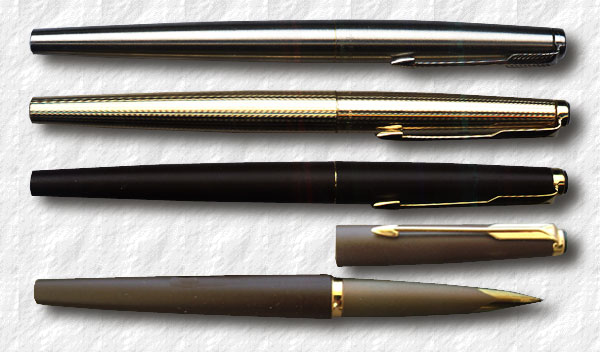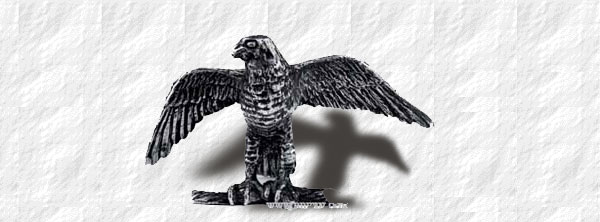
| parkerpens.net |
| PARKERCOLLECTOR.COM |
1978—1982 |
||
In time for the christmas season 1978 the Parker "50" Flighter appeared on the shelves. It borrowed many features from the predecessor Parker "T1" with one big difference: it was made of steel, not titanium. The Falcon had a body ring, a bit broader in comparison to the one on the T1 and while the T1 had a small breather hole in the nib-part, the Falcon had not, instead the brushing, or rather frosting, ended in a tip on top of the nib, creating a striking effect. It was also a little slimmer and longer than the Parker "T1" had been. |
It sold very well and Parker realised it's potential. Cashing in Parker raised the prices for 1980. Now a Flighter fountain pen cost $30, a ball pen $17 and a set $47.50 (still no real bargain for the set). A Falcon in a Matte Black finish was also introduced referred to as the 50B or TX and a year later, in 1981, the Gold version, or Signet, was launched as a part of the heritage collection. It was referred to as "the luxury look of tapered 12k gold fill". Matching pencils were also offered. The gold Falcon cost $125, the ballpen $75 and the pencil, with a 0.7 led, $75 as well. A ball/fountainpen set was offered for $150. Extra fine was added to the nib size options. |
|
 |
Falcon Flighter, Signet, TX and Matte brown (open) from around 1980. |
|
To mark the introduction of the Falcon in 1978 Parker commissioned a limited edition of 100 statuettes of a Peregrine Falcon in sterling silver, based on the design of Alex Jardine, of the Society of Wildlife Artists. |
 |
A Falcon Secretary pen from around 1980. |
|
A Falcon statuette limited edition, 1978. |
© 1995-2019 Tony Fischier and The Parker Pen Company®/Sanford Ecriture.
This page is in no way sponsored by or created by the Parker Pen Company®. All opinions, views, and thoughts expressed herein are expressly the authors, and in no way reflect the opinions, views, or thoughts of the Parker Pen Company®/Sanford Ecriture. All logos and/or images on these pages are © Copyright of Parker Pen Company®Sanford Ecritureunless otherwise stated and is reprinted by kind permission. If You feel that Your copyright has been violated please contact the WEBMASTER.
Everything on this website is copyrighted by law and can not be used without written permission from the author, Tony Fischier. You may however use the information as reference material and although it is forbidden to make digital copies or reproductions it may be physically printed for personal use, which does not include use on other web pages or in advertising. You may however quote parts of the content of this website, digitally or physically, providing that the source and author is clearly stated, together with the copyright information. In the US referred to as Fair use. If you use any information on this site, add a link.
Feel free to donate a small sum through Paypal to help this site to stay online. Acknowledgements.
Parkercollector.com in translated versions

 Image © Bernard Bernolet Dethières courtesy of
Image © Bernard Bernolet Dethières courtesy of